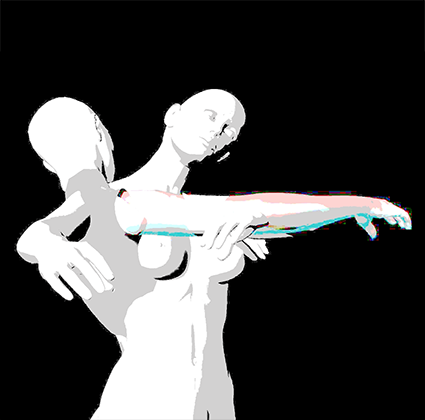TEACHING

Melissa Shaw, still from Sleep Paralysis, final project
Art 143 (3D Computer Modeling)
Courses at CSUS
Art 97 – Beginning Electronic Art
Art 97 Beginning Electronic Art is an introductory class in digital art. It focuses on learning and experimenting with digital media processes, and on assignments that utilize those processes creatively. A wide range of digital imaging techniques are explored, and time-based processes are introduced, leading to the creation of digital images, animations/videos and mixed media objects. The course will also explore artists’ uses of new technologies in contemporary art-making practices.
Art 197 – Intermediate Electronic Art
Following on from Art 97, Art 197 extends the possibilities of digital art in 2D animation, motion, sound, and time. The course includes a series of exercises and creative projects that address digital aesthetics, skill development, conceptual exploration and creative output in experimental animation.
Art 198 – Advanced Electronic Art
The focus of this class is the creation of interactive digital narratives using popular digital technologies. Relating to this focus the emphasis of the course will be placed on research and development of interactive narrative concepts that are realized into advanced creative projects. Independent problem solving and technical accomplishment in creative outcomes are necessary. An experimental approach to concept, process and execution of work is expected. In broader discussion artists uses of digital storytelling and narrative will be explored.
Art 142 – 3D Computer Modeling
In this course the 3D computer graphics (3D CG) software program, Maya is used to create 3D models and 3D virtual environments. Exercises, assignments are designed to build skill levels in 3D CG techniques, and lead to the creation of personally driven creative projects.
Art 143 – 3D Computer Animation
Art 143 is a 3D animation course. The course will cover major topics in 3D Computer Animation. While this is a skill-intensive subject, emphasis will be placed not only on developing necessary technical skills, but also on creative approaches leading to the development of original outcomes.
Art 199/299 – Undergraduate/ Graduate Independent Study
Art 297 – New Media 1
In this graduate level course, students will work on self-directed new media projects with the supervision of the instructor. The work will focus on projects based on digital image and animation, and works that also utilize other media or processes, such as intermedia, mixed media and installation work. The course includes reading assignments, critique and discussion.
Art 298 – New Media 2
The focus of this course is developing time-based and interactive artworks that utilize digital technologies. Emphasis will be placed on (1) the development of concepts (2) the realization of concepts as advanced creative projects (3) independent problem solving and (4) technical accomplishment in creative outcomes. An experimental approach to concept, process and execution of work is expected. Independent research and discussion will develop students’ awareness of the creative context. Group and one-on-one critiques will occur throughout the semester.
Art 222 – Graduate Seminar
The graduate seminar is about making and talking about art. It is the forum for graduate students to exchange ideas about the ongoing development of their studio practice and discuss its conceptual underpinnings via presentation, discussion and critique.
Teaching Statement
Self-reflection is at the heart of traditional art school education, along with risk-taking and experimentation in the formulation of a personally driven aesthetic. Alongside these are the development of discipline, intellectual rigor and clarity of purpose:
“Nothing can be learned if what is in place remains unexplained, un-interrogated or unquestioned” [Paul Welles and Johnny Hardstaff, Re-Imagining Animation p.19]
In my curriculum, I look at the ways artists have used the technologies of their time to create art, and at innovations in technology that have changed—and continue to change—both society and art. In addition, art historical references connect new and traditional media and practices, and show how artists have always taken radical approaches to express their age.
This engagement between art, culture, and technology sets up a dynamic frame of reference from which to embark.